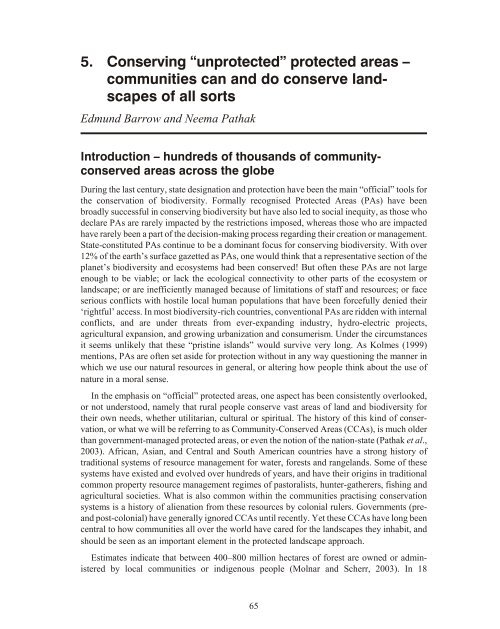The Protected Landscape Approach - Centre for Mediterranean ...
The Protected Landscape Approach - Centre for Mediterranean ...
The Protected Landscape Approach - Centre for Mediterranean ...
Create successful ePaper yourself
Turn your PDF publications into a flip-book with our unique Google optimized e-Paper software.
5. Conserving “unprotected” protected areas –<br />
communities can and do conserve land -<br />
scapes of all sorts<br />
Edmund Barrow and Neema Pathak<br />
Introduction – hundreds of thousands of communityconserved<br />
areas across the globe<br />
During the last century, state designation and protection have been the main “official” tools <strong>for</strong><br />
the conservation of biodiversity. Formally recognised <strong>Protected</strong> Areas (PAs) have been<br />
broadly successful in conserving biodiversity but have also led to social inequity, as those who<br />
declare PAs are rarely impacted by the restrictions imposed, whereas those who are impacted<br />
have rarely been a part of the decision-making process regarding their creation or management.<br />
State-constituted PAs continue to be a dominant focus <strong>for</strong> conserving biodiversity. With over<br />
12% of the earth’s surface gazetted as PAs, one would think that a representative section of the<br />
planet’s biodiversity and ecosystems had been conserved! But often these PAs are not large<br />
enough to be viable; or lack the ecological connectivity to other parts of the ecosystem or<br />
landscape; or are inefficiently managed because of limitations of staff and resources; or face<br />
serious conflicts with hostile local human populations that have been <strong>for</strong>cefully denied their<br />
‘rightful’ access. In most biodiversity-rich countries, conventional PAs are ridden with internal<br />
conflicts, and are under threats from ever-expanding industry, hydro-electric projects,<br />
agricultural expansion, and growing urbanization and con sumerism. Under the circumstances<br />
it seems unlikely that these “pristine islands” would survive very long. As Kolmes (1999)<br />
mentions, PAs are often set aside <strong>for</strong> protection without in any way questioning the manner in<br />
which we use our natural resources in general, or altering how people think about the use of<br />
nature in a moral sense.<br />
In the emphasis on “official” protected areas, one aspect has been consistently overlooked,<br />
or not understood, namely that rural people conserve vast areas of land and biodiversity <strong>for</strong><br />
their own needs, whether utilitarian, cultural or spiritual. <strong>The</strong> history of this kind of conser -<br />
vation, or what we will be referring to as Community-Conserved Areas (CCAs), is much older<br />
than government-managed protected areas, or even the notion of the nation-state (Pathak et al.,<br />
2003). African, Asian, and Central and South American countries have a strong history of<br />
traditional systems of resource management <strong>for</strong> water, <strong>for</strong>ests and rangelands. Some of these<br />
systems have existed and evolved over hundreds of years, and have their origins in traditional<br />
common property resource management regimes of pastoralists, hunter-gatherers, fishing and<br />
agricultural societies. What is also common within the communities practising conservation<br />
systems is a history of alienation from these resources by colonial rulers. Governments (preand<br />
post-colonial) have generally ignored CCAs until recently. Yet these CCAs have long been<br />
central to how communities all over the world have cared <strong>for</strong> the land scapes they inhabit, and<br />
should be seen as an important element in the protected landscape approach.<br />
Estimates indicate that between 400–800 million hectares of <strong>for</strong>est are owned or admin -<br />
istered by local communities or indigenous people (Molnar and Scherr, 2003). In 18<br />
65

















